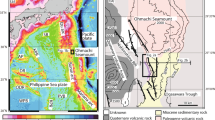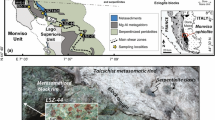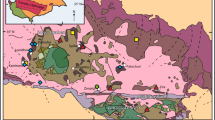Abstract.
Peridotites, dykes and gabbros from the 470–420 Ma Trinity Ophiolite Complex of northern California exhibit large geochemical rare earth element (REE) and Nd isotopic variations on the small scales which are indicative of a complex history. The Trinity Ophiolite, which covers an area of ≈1600 km2, consists of three distinct units: (1) a ∼2–4 km-thick sheet of plastically deformed peridotites, including various ultrabasic lithologies (plagioclase and spinel lherzolite, harzburgite, wherlite and dunite); the peridotite unit is a fragment of mantle lithosphere of oceanic affinity; (2) a series of small (∼1 km diameter) undeformed gabbroic massifs; (3) several generations of basic dykes. The peridotites display the largest geochemical and isotopic variations, with ɛNd(T) values ranging from +10 down to 0. In the gabbroic massifs and intrusive dykes, the variation in model ɛNd(T) values is reduced to 7 ɛNd units: 0 to +7. As a general rule, peridotites, gabbros and dykes with ɛNd(T) values around 0 or +3 give less depleted L(light)REE patterns than do those with ɛNd(T) values in the range +7 to +10. In the peridotites, the Nd isotopic variations take place over very short distances, with jumps as large as 7 ɛNd units occurring on scales of less than 20 m. Comparison with available age data indicates that the peridotites with ɛNd(T)≈+10 could be slightly older than the intrusive gabbro massifs and basic dykes (470 Ma vs. 420 Ma). Strontium isotopic data used in connection with Sm-Nd results demonstrate that the 10 ɛNd units variation displayed by the Trinity Peridotite is a primary feature and not an artefact due to REE mobility during seawater interaction. The variable Nd isotopic signatures and variable LREE patterns in the Trinity Peridotite cannot represent mantle source characteristics as there is evidence that this unit was partially melted when it rose as part of the upwelling convecting mantle. Field, petrographic, geochemical and isotopic data rather suggest that the observed heterogeneity is due to local reactions between a 470 Ma proto-peridotite with ɛNd(T)=+10 and younger (420 Ma) basaltic melts with lower ɛNd(T) values (i.e. the gabbroic massifs and the dykes). The gabbros and basic dykes of the Trinity Complex have geochemical and isotopic compositions similar to the arc basalts from the adjacent Copley Formation, so it is proposed that the younger melts are related to arc magmatism.
Similar content being viewed by others
Author information
Authors and Affiliations
Additional information
Received: 13 January 1995/Accepted 5 May 1995
Rights and permissions
About this article
Cite this article
Gruau, G., Bernard-Griffiths, J., Lécuyer, C. et al. Extreme Nd isotopic variation in the Trinity Ophiolite Complex and the role of melt/rock reactions in the oceanic lithosphere. Contrib Mineral Petrol 121, 337–350 (1995). https://doi.org/10.1007/s004100050100
Issue Date:
DOI: https://doi.org/10.1007/s004100050100




